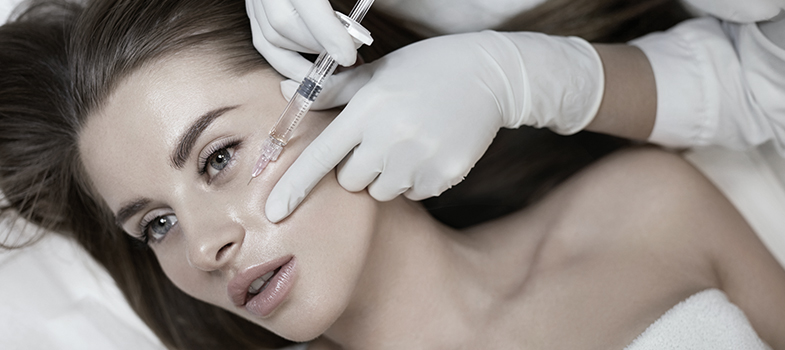
Hyaluronidase treatment

Injections with hyaluronic acid are becoming increasingly popular. Nevertheless, complications or dissatisfaction with the result can also arise here. However, the injected hyaluronic acid can be completely dissolved again using the endogenous enzyme hyaluronidase.
At a Glance
Medical term: hyaluronidase
Type of anaesthesia: none or anaesthetic cream
Duration of the procedure (treatment time): approx. 15 minutes
Clinic stay: outpatient
Aftercare: none
Back to public: immediately
Back to work: immediately
Recovery period: none
What is hyaluronidase and how does it work?
Hyaluronic acid is a substance produced naturally in the body that binds moisture in the cells. This is why there is also an ‘antagonist’, the enzyme hyaluronidase, which can break down the hyaluronic acid and thus degrade it. We only use hyaluronidase against introduced hyaluronic acid preparations.
Am I a suitable candidate for the treatment?
Treatment with hyaluronidase, often also simply called hyalase, is an option for anyone who is dissatisfied with the result of their hyaluronic acid injection caused by so-called granulomas (nodules in the lip). These lumps or bulges can appear after the hyaluronic acid injection and should disappear on their own after a short time. If they are still present more than 14 days after the filler treatment, this is referred to as a foreign body granuloma, which can be treated with hyaluronidase. Hyalase treatment can also be considered if the patient does not like the result of the filler treatment. For example, this may be the case if too much volume was injected, the result is asymmetrical or an allergic reaction has occurred.
Procedure
An allergic reaction to the hyaluronidase enzyme is unlikely. For people with a strong tendency to allergies, a patch test is carried out after the briefing. In this test, a minimal amount of the enzyme is injected into the arm to ensure that no allergic reaction occurs. An anaesthetic cream is applied before the actual treatment. A very fine needle is then used to inject the enzyme hyaluronidase directly into the area where the hyaluronic acid product was previously injected. The hyaluronic acid is broken down within one to two days.
After-effect
We recommend not applying make-up to the treated area on the day of the treatment. However, the enzyme makes no distinction between endogenous and exogenous hyaluronic acid. The treatment should therefore only be carried out by trained doctors to avoid unappealing results.
After the treatment, reddening may occur briefly at the injection sites. Slight swelling may also occur in the treatment area. However, both after-effects subside within a short time as soon as the product takes effect. If another injection of hyaluronic acid is planned, at least two weeks should pass after the hyaluronidase treatment before the filler is injected again.
Costs of hyaluronidase
The costs vary depending on the amount of preparation required and are determined on a case-by-case basis. We will discuss the exact cost of treatment during a consultation. As this procedure is purely cosmetic, health insurance companies do not usually cover the costs.
FAQ
What is hyaluronidase and what is it used for?
Hyaluronidase is an enzyme that breaks down hyaluronic acid. It is mainly used to dissolve excess or unwanted hyaluronic acid fillers after an injection and to make corrections.
How is the hyaluronidase treatment carried out?
In the hyaluronidase treatment, a very fine needle is used to inject the enzyme directly into the area where the hyaluronic acid preparation has previously been injected. The hyaluronic acid is broken down within 24 to 48 hours.
Is the hyaluronidase treatment painful?
Hyaluronidase treatment is generally well tolerated and only slightly painful. Upon request, an anaesthetic cream can be applied to increase comfort during the procedure.
Are there any side effects of hyaluronidase treatment?
Potential side effects of hyaluronidase treatment include redness, swelling, slight pain or bruising at the injection site. These side effects are usually mild and disappear within a few days.
Can anyone undergo hyaluronidase treatment?
People with a known allergy to hyaluronidase or a strong tendency to allergies should have a tolerance test carried out before treatment. Pregnant and breastfeeding women as well as people with active skin infections in the treatment area should avoid this treatment.
How quickly are the results of the hyaluronidase treatment visible?
The effect of the hyaluronidase treatment sets in quickly, and the hyaluronic acid is broken down within 24 to 48 hours. The final results are usually visible within a few days.
Is the effect of hyaluronidase treatment permanent?
The effect of the hyaluronidase treatment is permanent, as the enzyme completely breaks down the hyaluronic acid filler. However, additional injections of hyaluronic acid can be carried out, if necessary.









